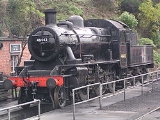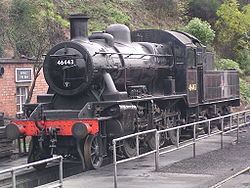
George Ivatt
Encyclopedia

Chief Mechanical Engineer
Chief Mechanical Engineer and Locomotive Superintendent are titles applied by British, Australian, and New Zealand railway companies to the person ultimately responsible to the board of the company for the building and maintaining of the locomotives and rolling stock...
of the London Midland and Scottish Railway. He was the son of the Great Northern Railway
Great Northern Railway (Great Britain)
The Great Northern Railway was a British railway company established by the Great Northern Railway Act of 1846. On 1 January 1923 the company lost its identity as a constituent of the newly formed London and North Eastern Railway....
locomotive engineer Henry Ivatt
Henry Ivatt
Henry Alfred Ivatt was the Chief Mechanical Engineer of the Great Northern Railway from 1896 to 1911.- Biography :...
.
Ivatt was born in Dublin in 1886, the son of Henry A. Ivatt, who later that year was appointed Chief Mechanical Engineer of the Great Southern and Western Railway
Great Southern and Western Railway
The Great Southern and Western Railway was the largest Irish gauge railway company in Ireland in the late 19th and early 20th centuries...
in Ireland. He was educated at Uppingham School
Uppingham School
Uppingham School is a co-educational independent school of the English public school tradition, situated in the small town of Uppingham in Rutland, England...
. In 1904, he started an apprenticeship at the Crewe Works of the London and North Western Railway
London and North Western Railway
The London and North Western Railway was a British railway company between 1846 and 1922. It was created by the merger of three companies – the Grand Junction Railway, the London and Birmingham Railway and the Manchester and Birmingham Railway...
(LNWR). After working in the drawing office, he became head of experimental locomotive work. He was appointed as Assistant Foreman at Crewe North Shed in 1909,
and a year later became Assistant Outdoor Machinery Superintendent.
During the 1914–1918 World War I
World War I
World War I , which was predominantly called the World War or the Great War from its occurrence until 1939, and the First World War or World War I thereafter, was a major war centred in Europe that began on 28 July 1914 and lasted until 11 November 1918...
Ivatt served on the staff of the Director of Transport in France
France
The French Republic , The French Republic , The French Republic , (commonly known as France , is a unitary semi-presidential republic in Western Europe with several overseas territories and islands located on other continents and in the Indian, Pacific, and Atlantic oceans. Metropolitan France...
. After the war, he became Assistant Locomotive Superintendent of the North Staffordshire Railway
North Staffordshire Railway
The North Staffordshire Railway was a British railway company formed in 1845 to promote a number of lines in the Staffordshire Potteries and surrounding areas in Staffordshire, Cheshire, Derbyshire and Shropshire....
(NSR) at Stoke-on-Trent
Stoke-on-Trent
Stoke-on-Trent , also called The Potteries is a city in Staffordshire, England, which forms a linear conurbation almost 12 miles long, with an area of . Together with the Borough of Newcastle-under-Lyme Stoke forms The Potteries Urban Area...
in 1919.
Under the Railways Act 1921, the NSR was absorbed (in 1923) into the London, Midland and Scottish Railway
London, Midland and Scottish Railway
The London Midland and Scottish Railway was a British railway company. It was formed on 1 January 1923 under the Railways Act of 1921, which required the grouping of over 120 separate railway companies into just four...
(LMS).
He was transferred to Derby Works
Derby Works
The Midland Railway Locomotive Works, known locally as "the loco" comprised a number of British manufacturing facilities in Derby building locomotives and, initially, rolling stock in Derby, UK.-Early days:...
in 1928 and appointed Locomotive Works Superintendent in 1931.
At the end of 1932 Ivatt moved to Glasgow
Glasgow
Glasgow is the largest city in Scotland and third most populous in the United Kingdom. The city is situated on the River Clyde in the country's west central lowlands...
, becoming Divisional Mechanical Engineer, Scotland
Scotland
Scotland is a country that is part of the United Kingdom. Occupying the northern third of the island of Great Britain, it shares a border with England to the south and is bounded by the North Sea to the east, the Atlantic Ocean to the north and west, and the North Channel and Irish Sea to the...
. He returned to England
England
England is a country that is part of the United Kingdom. It shares land borders with Scotland to the north and Wales to the west; the Irish Sea is to the north west, the Celtic Sea to the south west, with the North Sea to the east and the English Channel to the south separating it from continental...
in 1937 as Principal Assistant for Locomotives to the Chief Mechanical Engineer (CME), William Stanier
William Stanier
Sir William Arthur Stanier, FRS was Chief Mechanical Engineer of the London, Midland and Scottish Railway.- Biography :...
.
On his retirement in 1944, Stanier was succeeded as CME by Charles Fairburn
Charles Fairburn
Charles Edward Fairburn was Chief Mechanical Engineer of the London, Midland and Scottish Railway.- Biography :...
. When Fairburn died suddenly in October 1945, a new shortlist was prepared and George Ivatt, the senior candidate, with significant LMS locomotive experience, was appointed CME on 1 February 1946. Robert Riddles
Robert Riddles
Robert Arthur "Robin" Riddles, CBE, MIMechE, MinstLE was a British locomotive engineer.-LNWR and LMS:Riddles was born in 1892 and entered the Crewe Works of the London and North Western Railway as a premium apprentice in 1909, completing his apprenticeship in 1913...
, the other notable candidate for the post, was promoted to the board as Vice-President of the LMS.
As CME in post-war austerity
Austerity
In economics, austerity is a policy of deficit-cutting, lower spending, and a reduction in the amount of benefits and public services provided. Austerity policies are often used by governments to reduce their deficit spending while sometimes coupled with increases in taxes to pay back creditors to...
Britain, Ivatt continued to build standard existing LMS locomotive types for which parts were readily available. Two additional LMS Princess Coronation Class
LMS Princess Coronation Class
The London Midland and Scottish Railway Coronation Class is a class of express passenger steam locomotives designed by William Stanier. They were an enlarged version of the LMS Princess Royal Class. Several examples were originally built as streamlined, though this was later removed...
4-6-2 express locomotives were built and several modified black fives and the work of 'rebuilding' the Royal Scot and Patriot classes continued. The LMS Ivatt Class 4
LMS Ivatt Class 4
The LMS Ivatt Class 4 2-6-0 is a class of steam locomotive primarily designed for medium freight work but also widely used on secondary passenger services. The London Midland and Scottish Railway built 162 of this type between 1947 and 1952, but only three were built by the LMS before...
2-6-0 was introduced as well as the notable "Mickey Mouse" LMS Ivatt Class 2 2-6-0
LMS Ivatt Class 2 2-6-0
The London, Midland and Scottish Railway Ivatt Class 2 2-6-0 is a class of steam locomotive designed for light mixed traffic.-Design:...
and LMS Ivatt Class 2 2-6-2T
LMS Ivatt Class 2 2-6-2T
The London, Midland and Scottish Railway Ivatt Class 2 2-6-2T is a class of light 'mixed-traffic' steam locomotive introduced in 1946.- Background :...
, built to replace life expired 19th century branch line 0-6-0 and motor train 2-4-2T locomotive types, and the Class WT
NCC Class WT
The NCC Class WT is a class of 2-6-4T steam locomotives built by the Northern Counties Committee's parent company, the London, Midland and Scottish Railway for service in Northern Ireland.-History:...
2-6-4T locomotives for the Northern Counties Committee
Northern Counties Committee
The Northern Counties Committee was a railway that served the north-east of Ireland. It was built to Irish gauge but later acquired a number of narrow gauge lines...
. The famous Ivatt twins, diesel-electric locomotives numbered 10000 and 10001
British Rail Class D16/1
British Railways Class D16/1 or 10000 and 10001 were the first mainline diesel locomotives in Great Britain. They were built by the London, Midland and Scottish Railway at its Derby Works, using the EE16SVT 1600 hp diesel engine with electric transmission, in association with English Electric and...
, built by the LMS at Derby in association with English Electric
English Electric
English Electric was a British industrial manufacturer. Founded in 1918, it initially specialised in industrial electric motors and transformers...
were Britain's first main-line diesel locomotives and were designed to operate singly or in pairs. Contrary to popular myth they were not the prototype for the British Rail Class 44
British Rail Class 44
The British Rail Class 44 or Sulzer Type 4 diesel locomotives were built by British Railways' Derby Works between 1959 to 1960. They were named after British mountains, and consequently nicknamed Peaks.-Description:...
design.
On nationalisation in 1948, Riddles became CME of British Railways, whilst Ivatt remained as CME of the London Midland Region until his retirement in 1951. From mid-1951 Ivatt was a consultant and director of Brush Bagnall Traction, later becoming their General Manager. The first main line
diesel locomotives built by Brush, the Ceylon Government Railways class M1, delivered in 1953-55 have a noticeable similarity to LMS 10000 and 10001. Following the demise of Brush Bagnall Traction, Ivatt became a director of Brush Traction
Brush Traction
This article is about a British rail-locomotive maker. For the Detroit auto-maker, see Brush Motor Car CompanyBrush Traction is a manufacturer and maintainer of railway locomotives, part of the FKI group , based at Loughborough in Leicestershire, England situated alongside the Midland Main Line.-...
where he was involved with the building of the Brush Type 2 locomotives. He retired as a director in 1957 but was retained as a consultant until 1964.

